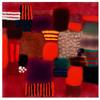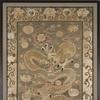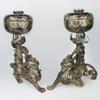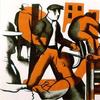RENOWNED ARTIST GLENN LIGON CURATES "BLUE BLACK," EXHIBITION EXPLORES MULTIPLE MEANINGS AND USES OF THE TWO COLORS ACROSS ARTISTIC PRACTICES
- ST. LOUIS, Missouri
- /
- May 10, 2017
The Pulitzer Arts Foundation in St. Louis presents Blue Black, an exhibition guest-curated by influential American artist Glenn Ligon. With more than 50 works ranging from abstraction, to portraiture, to “outsider art,” experimental film, textiles, and more—and including examples by Ligon—Blue Black explores a multiplicity of meanings and uses of the two colors. These include their deployment as discrete formal elements, their role as complex evocations of race, power, and sexuality, and their association with music, among other meanings and allusions. In so doing, the exhibition resists fixed interpretations, instead enlisting color to pose timely and nuanced questions.
Blue Black, which will not travel, will be on view at the Pulitzer from June 9 through October 7, 2017.
Pulitzer Arts Foundation Director Cara Starke notes, “In his work, Glenn Ligon brilliantly and subtly plumbs the overlapping complexities of American history, race, language, identity, and art. In Blue Black, he achieves this through curatorial practice—looking at the myriad artistic uses of the colors. The apparent simplicity of an exhibition based on two colors is belied by Ligon’s thoughtful, imaginative installation, which yields something like a work of contrapuntal or perhaps call-and-response music, in which the theme of blue and black is successively taken up and varied by individual works. The result is an exhibition in which artworks converse with, find echoes in, and add meaning to each other. We are grateful to Mr. Ligon for this thought-provoking, singular project.”
Exhibition
Mr. Ligon conceived of Blue Black on a visit to the Pulitzer where, upon seeing an Ellsworth Kelly wall-sculpture of the same title, he heard Louis Armstrong’s voice singing “What did I do to be so black and blue,” lyrics from Fats Waller’s Black and Blue. Although Kelly’s work is about color, shape, and form, the song reminded Ligon that “blue” and “black” have myriad other meanings as well, and the idea of an exhibition that would, in his words, “explore the space between Blue Black and ‘black and blue’” struck him as an interesting project.
As Ligon thought further, three ways of looking at blue and black in art came to mind and became a kind of lens through which he selected works for the exhibition. Identified by combinations of the title words, they are “Blue-Black,” in which nuances of color are a means of exploring identity, largely in portraiture and other figurative works; “BlueBlack,” which includes works in which the boundaries between the colors black and blue are blurred; and “Blue Black,” which encompasses works in which, as in the Kelly sculpture, the colors are discrete visual elements. While these groupings provide a conceptual structure for the exhibition, many works would be at home in more than one, and the exhibition does not strictly organize the artworks into those groups. The result is a display that is at once complex and provisional, enabling viewers to follow their own paths and experience numerous connections within and across the Pulitzer galleries.
The first work that visitors will see upon entering the museum is Invisible Man (after Ralph Ellison) (2008) by Tim Rollins and K.O.S. Comprising a grid of pages from Ellison’s masterwork superimposed with the letters “I” and “M”—through which the text is visible—with blue paint serving as negative space, the work brings language, color, and form together to contend with identity. Notably, the two letters can at once signify the title of the book and, especially when spoken, be understood as “I am,” an assertion of personhood that continues to be at the center of the search for racial justice, from the fifteenth amendment to the Black Lives Matter movement.
Elsewhere in this gallery, a variety of portraits reflect a wide range of perspectives. Untitled (Policeman), a 2015 painting by Kerry James Marshall, depicts a black police officer seated on the hood of his squad car in the evening. It’s a multilayered image, and one that complicates a dominant narrative of the relationship of the police with communities of color. Blue Black Boy (1997), Carrie Mae Weems’ stunning bust-length photograph of a young African American child looking into the camera, is one of the photographer’s “Colored People” series of works, in which she applies colored overlays to photographs of African American children, questioning the use of color as a means of categorizing people. Nearby, Messages from Elsewhere (2013), depicts an anonymous woman in a blue dress, viewed from the back, by Lynette Yiadom-Boakye, while Self-Portrait I (2014), by Jack Whitten, is a mosaic-like assemblage of mostly dark-blue “tesserae” against a field of midnight black. Finally, Dunham (2017), a sculpture by Simone Leigh, represents Katherine Dunham, a dancer and choreographer who introduced Caribbean and African movement to modern dance, and who lived in East Saint Louis for many decades. Leigh’s multi-medium portrait of her includes raffia, steel, and glass bead, materials associated with Caribbean and African art traditions.
The Pulitzer’s expansive main gallery is occupied by Ligon’s haunting A Small Band (2015). Comprising the words “blues,” “blood,” and “bruise” in black-coated neon, the monumental work—measuring some 66 feet in length and 6 feet in height—was inspired by the testimony of Daniel Hamm, a member of a group of young black men in Harlem who were wrongly accused of a minor infraction and detained by the police. He spoke about the brutality he experienced while incarcerated, noting that he had to open his bruises “to let some of the bruise blood come out” in order to make a case for his release from custody. One month later, in 1964, Hamm was falsely accused of murder, and spent nearly ten years in prison before he was eventually found not guilty on retrial. Ligon’s work references composer Steve Reich’s 1966 composition “Come Out,” which comprises taped testimony by Hamm. With its neon light, which provides a counterpoint to the otherwise naturally lit space of the gallery, and its massive scale, A Small Band cannot be ignored.
Moving through the main gallery, past the Kelly, visitors will reach a gallery containing a number of works in which the boundary between blue and black is not always clear. These include Chris Ofili’s nine-foot tall Blue Bathers (2014), in which the darkness of the two colors, and the closeness of their hues, challenges our ability to read the image. Like much of Ofili’s work, this one appears to contain references to classical mythology, perhaps the tale of Actaeon from Ovid’s Metamorphoses, which tells of the hunter Actaeon, who was transformed into a stag by the goddess Diana after he intruded on her while she was bathing in a grotto. Also here are Philip Guston’s Dark Room (1978), an image of a dark interior illuminated by a single pale-blue bulb; Mary Heilmann’s Maricopa Highway (2014), depicting a blacktop road rendered in shades of blue; and Susan Rothenberg’s The Caribbean (2015), showing two swimmers in translucent blue water that changes to black in the upper third of the composition.
The exhibition continues in the Pulitzer’s lower-level galleries, reached by descending the staircase presided over by the Kelly. One gallery here houses a single work: Blue (1993), a feature-length film by Derek Jarman in which a field of saturated blue, inspired by the color patented by French artist Yves Klein (1928–1962), serves as the background over which the artist’s journals and poetry are read aloud by a variety of voices, including his own. The 79-minute film, which will play in a loop, was released only months before the artist’s death from AIDS-related complications.
The large gallery on this level contains a diverse sampling of abstraction, including a group of paintings—such as Dead Reckoning I (1980), by Jack Whitten; Imploding Light (1967), by Richard Pousette-Dart, and Galaxy Painting (1993), by Ross Bleckner—that evoke the night sky and infinity. Other abstract paintings here include Joan Miró’s The Lasso (1927), in which delicate black linear forms seem to float on a luminous blue background; two works that associate the color blue with music—Jennie C. Jones’ Blue Serge (2015), a work on canvas—perhaps named after the 1956 album of the same title by saxophonist Serge Chaloff—to which the artist affixed an acoustic panel; and Norman Lewis’s Blue and Boogie (1974).
The historic notion of abstraction as painting on canvas is up-ended in this gallery by works that encompass textiles and that, though carefully composed, have a loose, improvisational feel. In David Hammons’s The New Black (2014), for example, a blue abstract work on canvas has been partially covered with a black tarp that hangs askew. Eric N. Mack’s Received All the Oohs and the Aahs (2013), is a collage made of magazine images, a blanket, and other textiles, and Turiya Magadlela’s I never made Swan Lake (2015) consists of blue and black nylon stockings, stitched together and stretched over a support, and two large Yoruba cloths (1960–70) that were dyed using traditional methods to achieve a deep blue/black color.
The final gallery of Blue Black illuminates numerous points of connection among a diversity of works. One wall is devoted to figurative art, with Kara Walker’s large-scale Four Idioms on Negro Art #1 Folk (2015), Malcolm Bailey’s Untitled, 1969 (1969); Ligon’s Malcolm X, Sun, Frederick Douglass, Boy With Bubbles (version 2) #2 (2001); and two of Jean Michel Basquiat’s paintings from the series To Repel Ghosts (1986), which evoke the figure through text. Another grouping encompasses abstract works, such as Kelly’s Black Blue (1959), an untitled work by Joan Mitchell (1958), and Louise Fishman’s NĀMARŪPA (2014). Finally, a dense, salon-like installation includes paintings by the self-taught Bill Traylor—Man and Woman (ca. 1939–42) and Man with Pipe and Bottle (ca. 1939–42); Andy Warhol’s silkscreened portrait of Liz Taylor (1963); Viviane Sassen’s photographs Kinee (2011) and Lemogang (2013); Terry Adkins’s abstract sculpture Oxidation Blue 1 (2013); four works on paper, evoking various portrait traditions, by Cecily Brown (2011, 2012); and a figure of a mother and child, in wood, by an unknown Yoruba artist of the mid-twentieth century.
Catalogue
Blue Black will be accompanied by a catalogue that features extensive installation photography as well as a fully illustrated checklist. The publication includes a curatorial essay by Ligon, who charts his longstanding engagement with the colors blue and black and his thinking behind the exhibition, as well as an essay by poet and critic Fred Moten, who offers a lyrical meditation on the shifting meanings of blue and black across art, poetry, music, and history. Released following the exhibition opening in order to accommodate the installation photography, the catalogue will be available free to all visitors to the Pulitzer, and complimentary copies can be ordered online for the cost of shipping.
About the Pulitzer Arts Foundation
The Pulitzer Arts Foundation, in St. Louis, MO, is one of the nation’s leading presenters of experimental, progressive, and multi-disciplinary art. With exhibitions and public projects that encompass both historic and contemporary art from across the globe, along with an equally diverse agenda of creative public programs, the Pulitzer seeks to heighten community engagement with art, and to inspire audiences to think differently about art and its relationship to their lives.
A non-collecting institution, the Pulitzer occupies one of the world’s most celebrated examples of museum architecture, a Tadao Ando-designed building that comprises spacious galleries illuminated by abundant natural light, creating poetic, multilayered experiences of the art within. Visit www.pulitzerarts.org.















